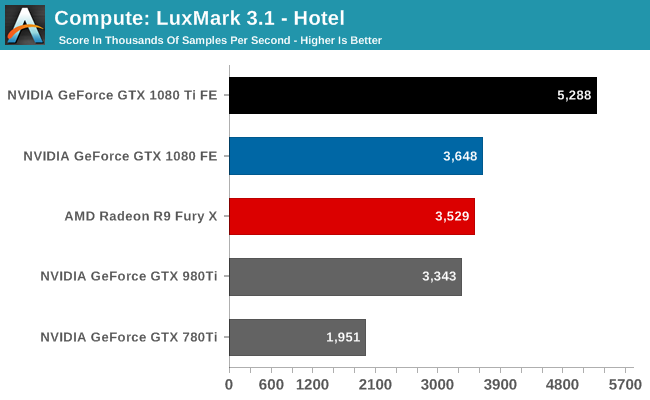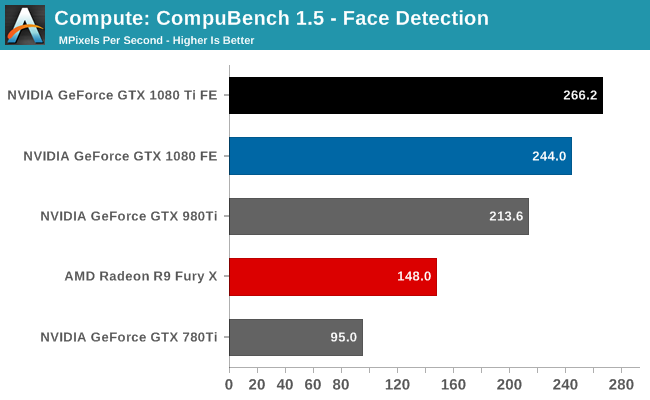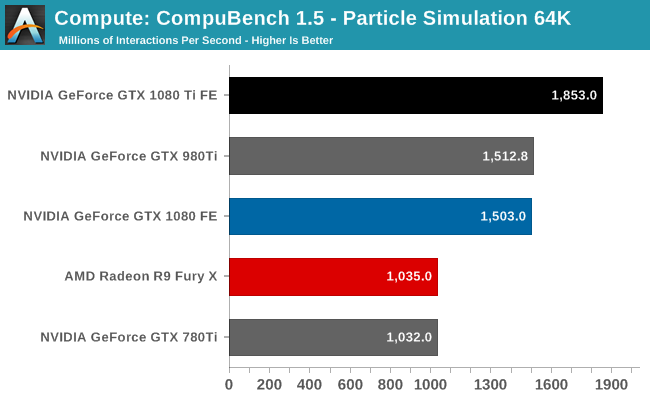The NVIDIA GeForce GTX 1080 Ti Founder's Edition Review: Bigger Pascal for Better Performance
by Ryan Smith on March 9, 2017 9:00 AM ESTCompute
Shifting gears, let’s take a look at compute performance on GTX 1080 Ti.
Starting us off for our look at compute is LuxMark3.1, the latest version of the official benchmark of LuxRender. LuxRender’s GPU-accelerated rendering mode is an OpenCL based ray tracer that forms a part of the larger LuxRender suite. Ray tracing has become a stronghold for GPUs in recent years as ray tracing maps well to GPU pipelines, allowing artists to render scenes much more quickly than with CPUs alone.

The OpenCL situation for NVIDIA right now is a bit weird. The company is in the middle of rolling out OpenCL 2.0 support to their video cards – something that I had actually given up hope on until it happened – and as a result their OpenCL drivers are in a state of flux as company continues to refine their updated driver. The end result is that OpenCL performance has dipped a bit compared to where the GTX 1080 launched at back in May, with said card dropping from 4138 points to 3648 points. Not that the GTX 1080 Ti is too fazed, mind you – it’s still king of the hill by a good degree – but the point is that once NVIDIA gets their drivers sorted out, there’s every reason to believe that NVIDIA can improve their OpenCL performance.
For our second set of compute benchmarks we have CompuBench 1.5, the successor to CLBenchmark. CompuBench offers a wide array of different practical compute workloads, and we’ve decided to focus on face detection, optical flow modeling, and particle simulations.



Like LuxMark, CompuBench shows some minor performance regressions on the GTX 1080 as compared to the card’s launch. None the less, this doesn’t do anything to impede the GTX 1080 Ti’s status as the fastest of the GeForce cards. It dominates every sub-benchmark, including Optical Flow, where the original GTX 1080 was unable to pull away from AMD’s last-generation Radeon R9 Fury X.










161 Comments
View All Comments
SaolDan - Thursday, March 9, 2017 - link
i dont need it but i really want it. currently gaming and vr on a 1070 and loving it.Endda - Thursday, March 9, 2017 - link
Would have loved to see the Titan XP in those graphsRyan Smith - Thursday, March 9, 2017 - link
Unfortunately NVIDIA never sampled us on that one, so I don't have one on-hand to test again.Samus - Thursday, March 9, 2017 - link
Can't wait to pickup one of these in a year for ~$400. Easily future-proof for the next generation of console games, and my 780Ti is really showing its age, by about 154%...Nfarce - Friday, March 10, 2017 - link
If you think you are going to see a 1080Ti in 12 months selling for $400, I've got a like-new Ferrari to selling you for $15k. It will be nearly summer before the AIB GPUs (ASUS, EVGA, Gigabyte, MSI, etc.) start becoming available in decent supply.rtho782 - Thursday, March 9, 2017 - link
I know I'm an outlier, but having lived with SLI 980s for a couple of years I'm looking to go back to a single card, and I really wish I could find SLI 980 to 1080ti benchmarks :PDrumsticks - Thursday, March 9, 2017 - link
I think the original AT review of the 1080 compares them. Go there and just tack on another 30% maybe?mapesdhs - Saturday, March 11, 2017 - link
If it's of any help, I've done a fair few 980 SLI tests for 3DMark, Unigine, etc., you could compare those to 1080 Ti reviews (several sites have included 3DMark results, and Techpowerup has a couple of Unigine results threads/tables); PM me for links, or email (Google "Ian SGI", find the Contact page, use my Yahoo address).Achaios - Thursday, March 9, 2017 - link
It should be borne in mind that Benchmark results are misleading, especially when referring to the 780TI.The 780TI launched at ridiculously low clocks of 875MHz Core Clock and 928 MHz Boost Clock, which wasn't much different from what a GTX 580 OC'd could do.
When overclocked, the 780TI worked at around 1.25 GHz, a huge difference over the stock card.
So, while the 1080TI has got more than double the performance of an OC'd 780TI as per 3D Mark Firestrike, the performance shown herein for the 780TI is ridiculously low and thus, misleading.
Yojimbo - Thursday, March 9, 2017 - link
I guess if you're worried about someone making judgments of general GPU trends without fully researching it, that's true. But owners of 780 Ti cards should be aware of where their individual cards sit compared to the reference design. In any case it's always going to be hairy taking overclocking performance into account when making judgments about generational trends. For instance, 2017 1060s and 1080s are going to be able to overclock better than 2016 1060s and 1080s. There's also a whole range of clock speeds that come out. Do you take the fastest or the average? If you take the average do you take the average of the SKUs or an average weighted by units sold? It's not so easy to get an accurate picture without a lot of work.